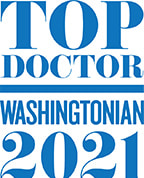
The cornea is the clear dome-shaped layer at the very front of the eye. It covers the pupil and the colored iris. In a healthy eye, there is a balance between the fluid moving into the cornea and fluid pumping out of the cornea. The cornea serves several important functions for good vision:
- Focusing the light that comes into the eye onto the lens. The lens refocuses that light onto the retina. The light rays are then interpreted by the brain, which allows us to see.
- Filtering damaging UV light from the sun.
- Protecting the eye from germs and bacteria.
Your eye care specialists at See Clearly Vision in Arlington and Tyson’s Corner have experience caring for corneal diseases and conditions.
What Is Conjunctivitis?
Conjunctivitis is a common disorder affecting millions of people each year. It is often called “pink eye” because the inflammation makes blood vessels more visible and gives the eye a reddish appearance. Conjunctivitis can often occur because of several different things. These include bacterial or viral infections, allergies, and exposure to strong cleaners and chemical fumes. Conjunctivitis can be highly contagious. It can reoccur or infect others without proper hygiene and infection control practices.
What Is Dry Eye?
Dry eye is an uncomfortable condition that occurs when the eyes do not create enough tears or low-quality tears.
What Is Corneal Dystrophy?
Corneal dystrophy refers to a group of genetic eye disorders. These occur when abnormal material tends to accumulate in one or more layers of the cornea. They can cause the cornea to lose its transparency, causing loss of vision or blurred vision.
What Is Fuch’s Dystrophy?
Fuch’s dystrophy is a slowly progressing disease that usually affects both eyes. It can cause vision deterioration over time. Symptoms include glare, blurred or distorted vision, halos, and painful, tiny blisters on the surface of the cornea. Severe cases may need treatment with a corneal transplant.
What Is Keratoconus?
Keratoconus is a progressive condition in which the cornea gradually thins. As the cornea thins, it also develops an abnormal curvature resembling a cone. Keratoconus often affects both eyes. It can cause blurry or double vision, difficulty with distance vision, and sensitivity to light. Your See Clearly Vision eye specialist may use recommend specially fitted contact lenses to correct corneal distortion. In most cases, the problem resolves after a few years.
What Is A Pterygium?
A pterygium is a pinkish wedge-shaped growth on the cornea, which usually begins near the nose. Although benign (non-cancerous), it can sometimes grow large enough to interfere with vision. Doctors believe pterygium may occur due to excessive exposure to UV rays from the sun.
Corneal Ulcers
Corneal ulcers are most commonly caused by infections. Infection can be due to bacteria, viruses, fungi or parasites. Risks for corneal ulcer are contact lens use, trauma, or coming into contact with contaminated substances. Symptoms include decreased vision, redness, drainage, tearing, and light sensitivity. A corneal ulcer can result in vision loss and blindness. Treatment requires early recognition and antibiotic, antifungal or antiviral eye drops depending on the cause. Severe cases may require surgery.
What Are The Options For Treating Corneal Diseases And Conditions?
There are a wide variety of treatments for the various types of corneal conditions. These include medicated eye drops, procedures, and surgery. See Clearly Vision eye surgeons have extensive knowledge in several state-of-the-art corneal procedures. They include the following:
Corneal Collagen Cross-Linking
This is an office surgical procedure used to treat keratoconus. Corneal collagen cross-linking is completely painless, thanks to numbing eye drops. The procedure only takes about 60 minutes to complete. The surgeon gently removes the epithelial layer of the cornea and then applies riboflavin (B2) eye drops to the surface of the eye. After applying riboflavin eye drops, controlled ultraviolet light treats the eye. After the treatment, the doctor will apply a special contact lens called a bandage contact to protect the eye. Post-surgery, the surgeon prescribes antibiotics and anti-inflammatory drops. The goal of corneal collagen cross-linking is to slow disease progression and prevent any further damage to your eyes.
Pterygium Removal
This surgery removes the growth of the conjunctiva that extends from the corner of the eye onto the cornea. The surgeon replaces the growth with healthy tissue from the patient’s own eye that is either stitched or glued into place. With newer techniques, recovery is fast, and there is a low rate of pterygium recurrence.
ProKera, AmbioDisk, And Aril
ProKera, AmbioDisk, and Aril are types of amniotic membrane tissue used to promote healing of eye surface wounds. They also reduce scarring and inflammation. They can be safely and effectively applied to the cornea at all our See Clearly Vision offices.
Phototherapeutic Keratectomy (PTK)
PTK is a minor surgical procedure. It uses an excimer laser to treat conditions on the surface of the cornea such as corneal opacities and corneal erosions. The laser removes a small outer layer of tissue from the cornea.
Corneal Transplant Surgery
If the cornea cannot be healed or repaired with medications or other procedures, you may need a cornea transplant. Depending on the severity of the problem, part or all the diseased cornea is removed. The diseased cornea is then replaced with healthy corneal tissue. The healthy corneal tissue comes from a deceased person who has pledged to donate their organs before death. Donated tissue is tested thoroughly before surgery.
Are There Different Types Of Cornea Transplants?
Yes, there are several types of transplants that doctors recommend based on a patient’s needs:
Penetrating Keratoplasty involves removing the entire damaged cornea. The cornea gets replaced with a new, healthy cornea.
IntraLase Enable Keratoplasty (IEK) is a newer approach to corneal transplant surgery. IEK uses the IntraLase Excimer laser to create incisions in both the donor and recipient tissue. This creates a more precise match between the old cornea and the new one, resulting in a better fit. The outcome is usually faster healing and a better visual result.
Descemet’s Stripping Endothelial Keratoplasty (DSEK) is a partial transplant. DSEK is specifically for patients with damage to the endothelium (innermost layer) of the cornea. The Descemet’s membrane is part of the deep endothelial layer of the cornea. This procedure removes damaged cells from the Descemet’s membrane. After removing damaged cells, they are then replaced with healthy endothelial tissue. It is a less invasive surgery with a faster visual recovery.
Descemet Membrane Endothelial Keratoplasty (DMEK) – this is another type of partial thickness corneal transplant, but uses an even thinner tissue transplant than DSEK to replace only the damaged endothelial layer of the cornea. This technique allows for decreased rejection rates and faster visual recovery.
Interested in finding out more about the cutting-edge procedures that See Clearly Vision offers? Schedule an appointment with us today in Arlington or Tysons Corner!



















